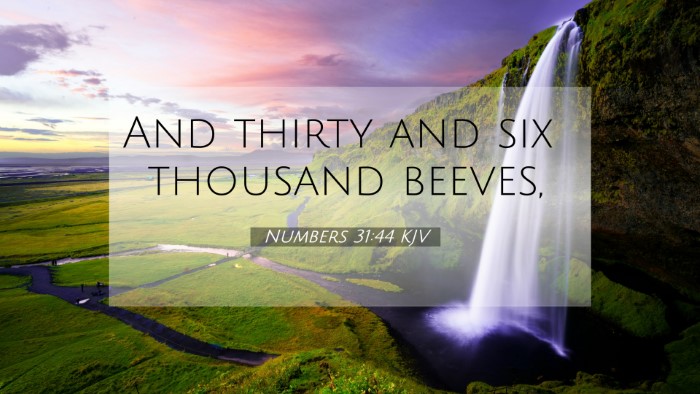Understanding Numbers 31:44
Numbers 31:44 states, "And the rest of the cattle, which is the prey of the people of Israel, which they had taken, was six hundred and seventy-five thousand." This verse offers insights into the aftermath of the battles fought by the Israelites against the Midianites, outlining the spoils of war they collected. To comprehend its full meaning, we can draw upon the interpretations presented in public domain commentaries.
Contextual Overview
Numbers 31 details God’s command for the Israelites to take vengeance on the Midianites due to their lead in false worship and the sin they introduced among the Israelites. Following their victory, the number of cattle and other spoils is presented, emphasizing the magnitude of their conquest.
Commentary Insights
-
Matthew Henry’s Commentary:
Henry emphasizes the significance of obedience to God's commands. The vast amount of cattle reflects both God’s favor towards the Israelites and a physical manifestation of their victory. It serves to demonstrate God’s provision.
-
Albert Barnes’ Notes:
Barnes provides insights into the numbers stated here. He notes that the total reflects not just material wealth but a divine blessing on their endeavors, reaffirming the covenant promise of abundance to the Israelites, highlighting God’s faithfulness.
-
Adam Clarke’s Commentary:
Clarke points out the symbolism of cattle in ancient Israelite culture, representing wealth and status. He suggests that the large number serves to indicate the complete overthrow of the Midianite threat and God's hand in the Israelites' success.
Interpreting Numbers 31:44
This verse is pivotal as it bridges themes of divine justice, fulfillment of promises, and the deity’s provision. The Israelites’ victory and the spoils they received are deeply interconnected with their covenant relationship with God.
Bible Cross-References
- Deuteronomy 20:14: This verse discusses the spoils taken in warfare, highlighting laws concerning captured goods.
- Joshua 11:14: Refers to the complete victory over enemy nations and the resultant spoils.
- 1 Samuel 15:3: Illustrates the command to utterly destroy the people and the livestock, similar to the context here.
- Psalms 68:12: Speaks of the kings of armies fleeing and dividing the spoils, showing victory by divine intervention.
- Exodus 15:9: Reflects on the Egyptians’ thoughts during the crossing of the Red Sea, showcasing God’s power in battle.
- Genesis 14:14-16: Discusses Abram’s rescue of Lot and the spoils that he reclaimed, mirroring the theme of warfare spoils.
- Hebrews 11:32-34: Highlights faith in battles won and the accomplishments through divine aid, paralleling Numbers 31:44.
Thematic Connections
Numbers 31:44 ties into several broader themes within the Scriptures:
- Divine Justice: The defeat of the Midianites serves as a judgment against their sins.
- God's Provision: The spoils demonstrate God's ability to provide abundantly for His people.
- Faithfulness of God: Reminds us of the promises made to Israel about the land and its blessings.
Tools for Bible Cross-Referencing
To understand the connections and references effectively, utilize tools like:
- Bible concordance for locating keywords in Scripture.
- Bible reference resources that provide comprehensive thematic studies.
- Cross-reference Bible study guides to explore relationships between verses.
Conclusion
Numbers 31:44, while a verse about the spoils following battle, speaks to larger themes of divine intervention, justice, and the faithfulness of God to His covenant people. The analysis provided here and through various commentaries reveals the depth present in seemingly straightforward historical accounts. Cross-referencing with related verses enhances understanding of the unity and consistency in God’s dealings throughout the Scriptures.
Further Studies and Applications
For those interested in deeper studies, consider how this victory narrative parallels stories found in the New Testament, revealing God's continuous work through His people. Engaging in comparative Bible verse analysis can yield rich insights and guide practical applications for faith and life.


